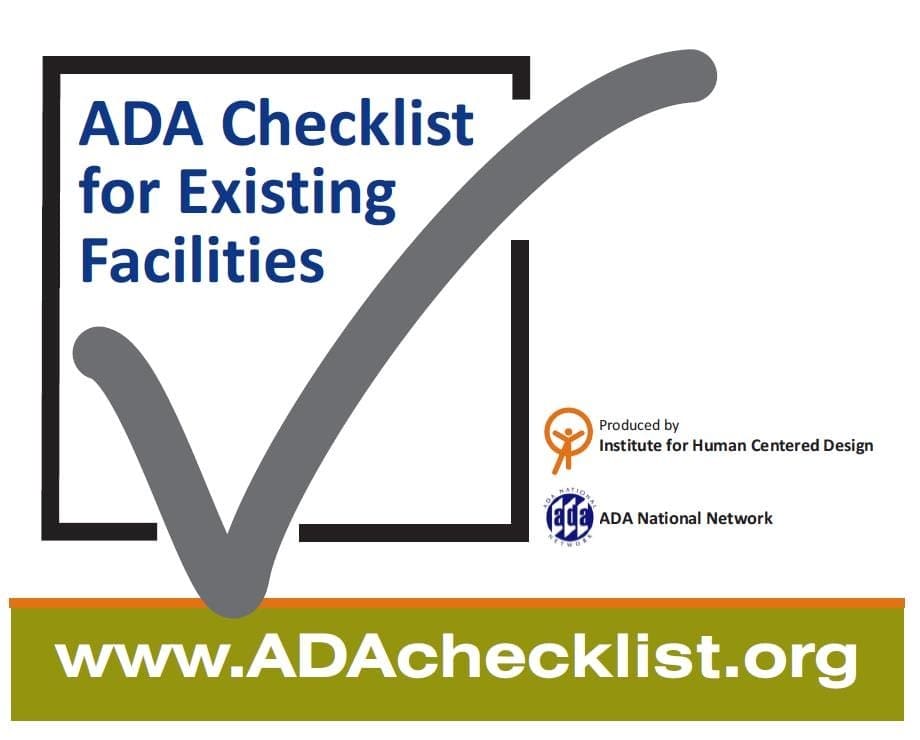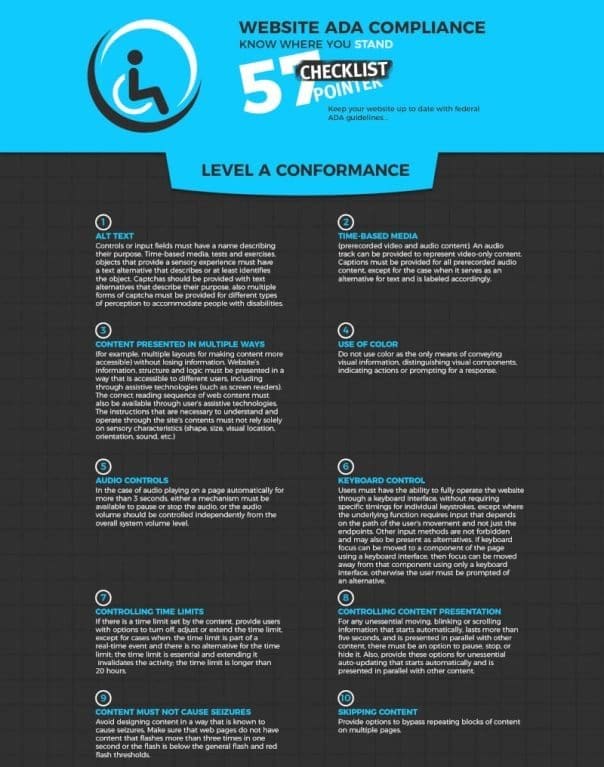If you own a small business, ensuring that it is ADA compliant is essential. The Americans with Disabilities Act (ADA) sets forth guidelines to make businesses accessible and inclusive for individuals with disabilities. To help you navigate through the requirements, we have created a comprehensive ADA compliance checklist specifically tailored for small businesses. From physical accessibility to online accommodations, this checklist will serve as a helpful resource to ensure your business is welcoming to all customers.

This image is property of adata.org.
Physical Accessibility
Parking
When it comes to physical accessibility, having accessible parking spaces is crucial. These spaces should be wide enough to accommodate wheelchair users and have proper signage indicating their designation. It's important to ensure that these parking spaces are located close to the entrance of your business to provide easy access for individuals with disabilities.
Ramps and Walkways
Installing ramps and maintaining accessible walkways are vital for individuals with mobility impairments. Ramps should have a slope that complies with ADA standards, allowing wheelchair users to navigate smoothly. It is also essential to ensure that walkways are free from any obstacles such as debris or uneven surfaces, which can pose a significant challenge to people with disabilities.
Entrances
To make your business accessible to everyone, it is crucial to have entrances that are wide enough and have doorways with proper clearance. This allows individuals who use mobility aids, such as wheelchairs or walkers, to enter your establishment comfortably. Additionally, consider installing automatic door openers to further enhance accessibility.
Doorways and Hallways
Inside your business premises, it is important to ensure that doorways and hallways are wide enough for individuals with disabilities to maneuver easily. This includes having doorways that are a minimum of 32 inches wide and hallways that have adequate space for wheelchair users to pass through without any obstructions.
Restrooms
Accessible restrooms are a fundamental requirement for any business. These restrooms should have sufficient space for individuals in wheelchairs to navigate, grab bars strategically placed for support, and accessible sinks and toilets. It's also important to keep these restrooms fully stocked and well-maintained to cater to the needs of all individuals.
Digital Accessibility
Website
In today's digital age, ensuring that your website is accessible is crucial for reaching and serving a wide range of individuals. This includes providing alternative text for images, ensuring proper color contrast, and using descriptive headings to improve navigation for individuals using screen readers. It is also important to ensure that your website is compatible with assistive technologies and can be easily navigated with keyboard-only inputs.
Content and Media
When creating content for your website or other digital platforms, it's important to consider accessibility. This means providing text alternatives for any non-text content, such as images or videos, so that individuals with visual impairments can understand the information being conveyed. Furthermore, captioning videos and providing transcripts for audio content are necessary to make them accessible to all individuals.
Forms and Applications
If your business requires individuals to fill out forms or applications, it's crucial to make these documents accessible. This includes ensuring that the forms can be filled out electronically and are compatible with screen readers. Additionally, providing instructions on how to complete the forms for individuals with disabilities can greatly improve accessibility.
/eZ7ddmeCPBw” frameborder=”0″ allowfullscreen>
Communication Accessibility
Auxiliary Aids and Services
To ensure effective communication with individuals who have hearing or speech impairments, providing auxiliary aids and services is essential. This may include options such as sign language interpreters, captioning services for videos or presentations, or assistive listening devices. By offering these accommodations, you can ensure that everyone can fully participate in discussions and interactions.
Signage and Information
Having clear and accessible signage is crucial for individuals with vision impairments. This includes using large, bold fonts for easy readability, providing raised lettering and Braille for tactile navigation, and utilizing high contrast colors for improved visibility. Additionally, it's essential to provide information in accessible formats upon request, such as large print or electronic documents.
Employee Accessibility
Job Recruitment
When hiring new employees, it's important to ensure that your recruitment process is inclusive and accessible to individuals with disabilities. This means providing alternative application methods, such as accepting applications online or over the phone, and clearly stating that you welcome applicants with disabilities. Additionally, consider making reasonable accommodations during interviews and assessments to ensure equal opportunities for all candidates.
Training and Meetings
To create an inclusive work environment, providing accessible training and meetings is crucial. This includes offering materials in accessible formats, such as electronic documents or Braille, and utilizing assistive technologies. Additionally, consider providing captioning or sign language interpreters for training sessions or meetings to ensure effective communication for all employees.
Workplace Accommodations
Making reasonable accommodations in the workplace is a legal requirement and a way to promote equal opportunity for individuals with disabilities. This may include providing adjustable desks or chairs, modifying workstations to accommodate mobility aids, or offering assistive technologies such as screen readers or speech recognition software. By assessing and meeting the specific needs of your employees, you can create a more inclusive and accessible work environment.

This image is property of www.accessibilitychecker.org.
Customer Service Accessibility
Policy and Procedures
Developing clear policies and procedures that prioritize accessibility is essential for providing exceptional customer service to all individuals. This includes training your staff on disability awareness and ensuring that they are knowledgeable about how to assist individuals with disabilities. It's essential to create an inclusive culture where every customer feels respected and accommodated.
Assistive Devices
Providing access to assistive devices can greatly enhance the customer experience for individuals with disabilities. This may include offering magnifiers for individuals with visual impairments, TTY devices for those with hearing impairments, or assistive listening systems for those who may struggle with hearing in noisy environments. By providing these devices, you show your commitment to accessibility and inclusivity.
Staff Training
Training your staff on disability awareness and appropriate communication techniques is crucial for delivering exceptional customer service. This includes teaching them how to interact respectfully with individuals with disabilities, providing guidance on how to assist with mobility issues, and ensuring that they are familiar with any accessibility features or accommodations available within your establishment.
Emergency Preparedness Accessibility
Evacuation Plans
Having accessible evacuation plans is vital to ensure the safety of all individuals during emergencies or evacuations. This includes providing clear and accessible exit routes, ensuring that these routes are wide enough for wheelchair users, and having procedures in place to assist individuals with disabilities in evacuating safely. It's also important to regularly review and update these plans to address any specific needs or changes in your business premises.
Notification Systems
During emergencies or evacuation situations, it's crucial to have effective notification systems in place to alert individuals with disabilities. This includes providing visual and audible alarms to cater to individuals with hearing or visual impairments. It is also important to establish a communication system to provide clear instructions and guidance to individuals with disabilities, ensuring they receive the necessary information to safely respond to the emergency.

This image is property of assets-global.website-files.com.
Public Accommodation Accessibility
Accommodation Spaces
When providing public accommodation spaces, it is essential to make these areas accessible to individuals with disabilities. This includes having accessible seating areas, shelving or displays at a reachable height, and ensuring that pathways through these spaces are wide enough for wheelchair users to navigate comfortably.
Furnishings and Equipment
Choosing accessible furnishings and equipment is important for ensuring that all individuals can use your services comfortably. This may include providing adjustable tables or desks, offering seating options with armrests for individuals who need additional support, and installing hearing loop systems for individuals with hearing impairments. By selecting the right furnishings and equipment, you can create an inclusive environment for all customers.
Documentation and Compliance
Recordkeeping
Maintaining proper records and documentation is crucial for ADA compliance. This includes keeping track of accessibility improvements made, providing documentation of employee accommodations, and retaining proof of compliance with ADA standards. Having organized and up-to-date records ensures that you can demonstrate your commitment to accessibility if required.
Compliance Assessments
Performing regular compliance assessments is important to ensure that your business continues to meet ADA standards. This involves evaluating your physical accessibility, website accessibility, and overall compliance with ADA guidelines. By conducting these assessments, you can identify areas for improvement and address any accessibility barriers that may arise, ensuring that your business remains accessible to all individuals.

This image is property of i0.wp.com.
Legal Responsibilities
ADA Standards
The Americans with Disabilities Act (ADA) sets the standards for accessibility in the United States. Familiarizing yourself with these standards and ensuring compliance is essential for avoiding legal issues and creating an inclusive business environment. The ADA covers a wide range of accessibility requirements and applies to businesses of all sizes, emphasizing the importance of accessibility for all individuals.
State and Local Laws
In addition to following the ADA standards, it's essential to be aware of any state and local laws regarding accessibility. These laws may provide additional requirements or specific guidelines that businesses need to comply with. By understanding and adhering to both federal and local regulations, you can ensure that your business meets the necessary accessibility standards.
Enforcement and Penalties
Department of Justice
The U.S. Department of Justice (DOJ) enforces ADA compliance and investigates complaints related to accessibility. It's important to be proactive in ensuring compliance rather than waiting for a complaint to arise. If your business is found to be in violation of ADA regulations, the DOJ can pursue legal action, resulting in fines, required accessibility improvements, and potential reputational damage.
Legal Actions
Failing to comply with ADA regulations can also lead to legal actions initiated by individuals with disabilities. This can result in costly lawsuits, damages, and attorney's fees. To avoid litigation and its associated penalties, it is crucial to prioritize accessibility and take necessary steps to ensure compliance.
In conclusion, ensuring accessibility in various aspects of your business is not only a legal requirement but also a way to create a more inclusive and welcoming environment for all individuals. By focusing on physical accessibility, digital accessibility, communication accessibility, employee accessibility, customer service accessibility, emergency preparedness accessibility, public accommodation accessibility, documentation and compliance, legal responsibilities, and understanding the enforcement and penalties involved, you can build a business that values inclusivity and serves all members of society.











